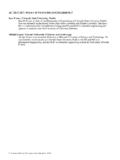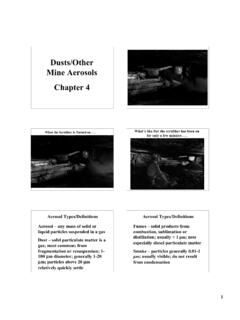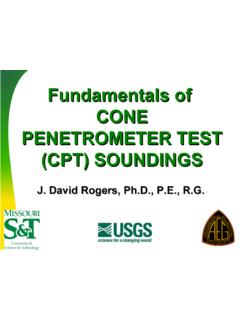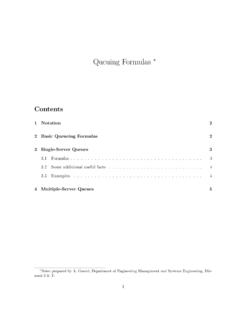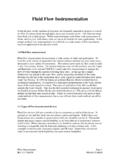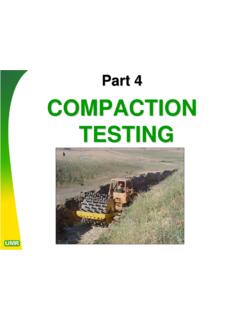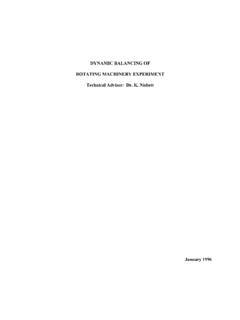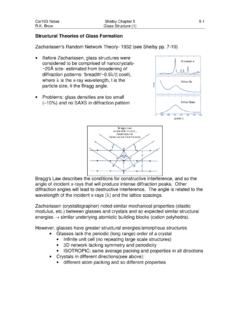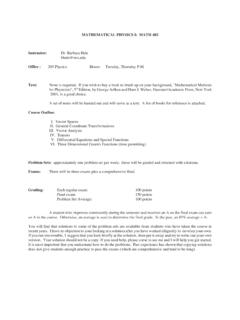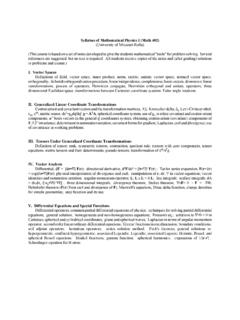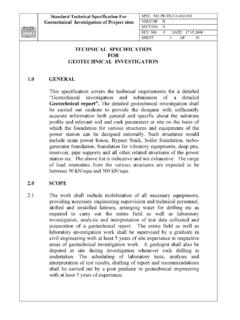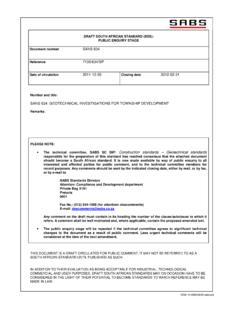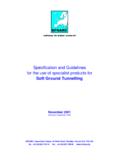Transcription of DETERMINATION OF EARTH PRESSURE …
1 DETERMINATION OF EARTH PRESSURE DISTRIBUTIONS FOR LARGE-SCALE RETENTION STRUCTURES J. David Rogers, , , geological Engineering University of Missouri-Rolla DETERMINATION OF EARTH PRESSURE DISTRIBUTIONS FOR LARGE-SCALE RETENTION STRUCTURES IntroductionVarious EARTH PRESSURE theories assume that soils are homogeneous, isotropic and horizontally inclined. These assumptions lead to hydrostatic or triangular PRESSURE distributions when calculating the lateral EARTH pressures being exerted against a vertical plane. Field measurements on deep retained excavations have shown that the average EARTH PRESSURE load is approximately uniform with depth with small reductions at the top and bottom of the excavation.
2 This type of distribution was first suggested by Terzaghi (1943) on the basis of empirical data collected on the Berlin Subway and Chicago Subway projects between 1936-42. Since that time, it has been shown that this uniform distribution only occurs when the following conditions are met: 1. The upper portions of the vertical side walls of the excavation are supported in stages as the excavation is deepened; 2. The walls of the excavation are pervious enough so that water PRESSURE does not build up behind them; and 3. The lateral movements of the walls are kept below 1% to 2% of the depth of the excavation.
3 With the passage of time, the approximately uniform PRESSURE distribution evidenced during construction has been observed to transition toward the more traditional triangular distribution . In addition, it has been found that the tie-back force in anchored bulkhead walls generally increases with time. The actual load imposed on a semi-vertical retaining wall is dependent on eight aspects of its construction: 1. The degree of saturation of the wall backfill in the zone of active or at-rest EARTH PRESSURE . 2. The degree of relative compaction of the wall backfill within the active or at-rest envelopes.
4 3. The structural stiffness of the retaining wall system and its ability to deflect outward in response to "active" EARTH loads. 4. The magnitude and inclination of thrust generated by soil loads due to either inclined bedding, filling, or finished grades behind the wall. 5. The inclination between the wall itself and the backfill materials. 6. The applicable skin friction at the wall/backfill interface. 7. The vertical and horizontal components of loads associated with structural tie-backs. 8. Live or dead surcharge loads above and/or behind the wall. Each of these factors should be considered and appropriately evaluated separately.
5 The final EARTH PRESSURE calculations can then be made which will incorporate the design life of the wall and the environmental extremes to which the wall will be subjected (such as likely fluctuations in the groundwater table or freezing ground, etc.). The following section outlines the design aids and procedures available for evaluating the above list of factors when calculating EARTH PRESSURE values. Calculating EARTH PRESSURE Values The engineer should begin by neatly sketching a scaled elevation view of the design section selected for consideration.
6 Upon this section, the various limits and types of subsurface materials may be labeled. Below this (or on the next page) a neat tabulation of the various soil types and their available soils properties should be listed as "Given Values". These values would typically include: soil bulk density and strength values derived from appropriate subsurface materials sampled in the field and then tested in the soils laboratory. At this juncture, the engineer should evaluate these values and the soils classifications made to see if they are commensurate with what he feels is representative of the site.
7 Anomalous or unrepresentative values should be stricken with a single pencil line and no longer considered in the analysis. A parenthetical note as to the reason for deleting this data should be added on the paper mar-gin if that data is to be retained on the boring logs. Calculations Involving Landslides In many situations, such as landslides, a discrete weak zone or discontinuity may have been responsible for the failure or another future movement. If such weak zones were encountered or suspected in the field investigation, care should be exercised in evaluating all of the field data.
8 In some situations, averaging of empirical data might be a viable approach to classifying some material. In other situations, values at the more conservative end of the data range might be selected as being more-representative of that particular weakness zone or zones which are critical to a stability analysis. To error on the side of conservatism is always considered to be the prudent alternative to choose. A back analysis of the slippage is another method which can be used to check the strength parameters chosen for the slip surface. Material PropertiesIn some cases, there is either a lack of reliable data or much of the data yielded in the investigation is not felt to be representative of, say, the weakest material.
9 In such cases, it is often possible to make correlations between either Standard Penetration Resistance (SPT) Values or Atterberg Limits values with the angle of internal friction, , of certain types of materials. Many such relationships have been presented over the years in the en-gineering literature. A brief listing of these relationships follows: Correlation Type of Soil SPT vs for sands e vs n vs d for sands Soil type vs unit weight all types d vs w/c all types vs type of soil all types PI vs for clays (drained) vs Rel.
10 Density for sands vs d, Dr sands, silts, gravel vs N granular mtls. Su vs SPT for clays PI vs OCR for clay Su vs for normally consolidated clay E, qu for types of rock Vp (P-wave velocity) all types When a property is chosen from one of these correlation charts or tables, the engineer should make a xerox copy of the chart or table, note its source, and properly highlight or underline the particular values given and the values chosen.
